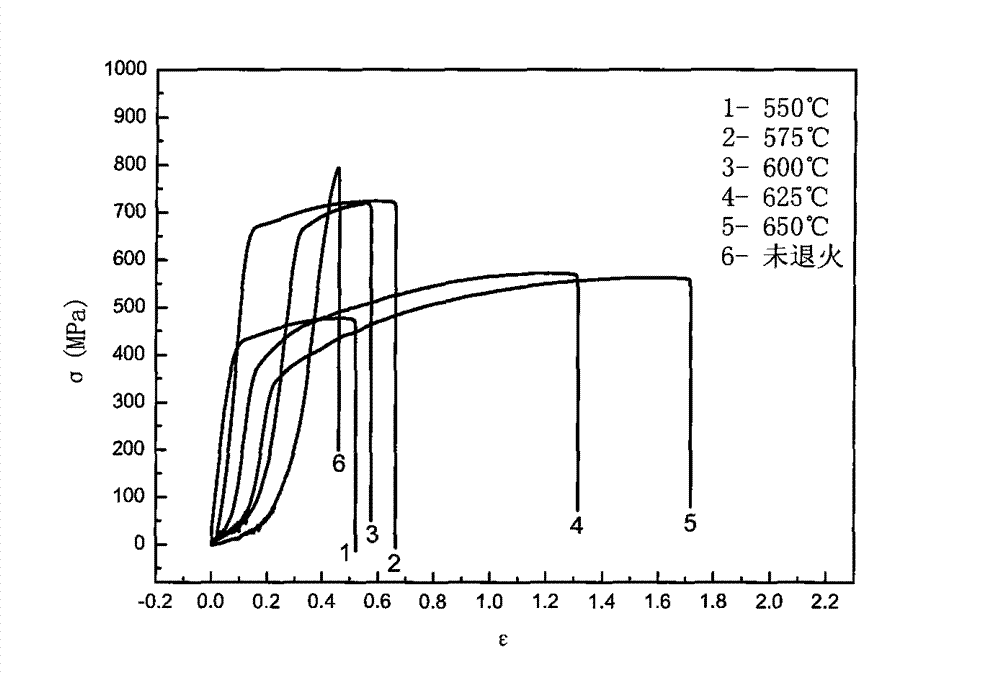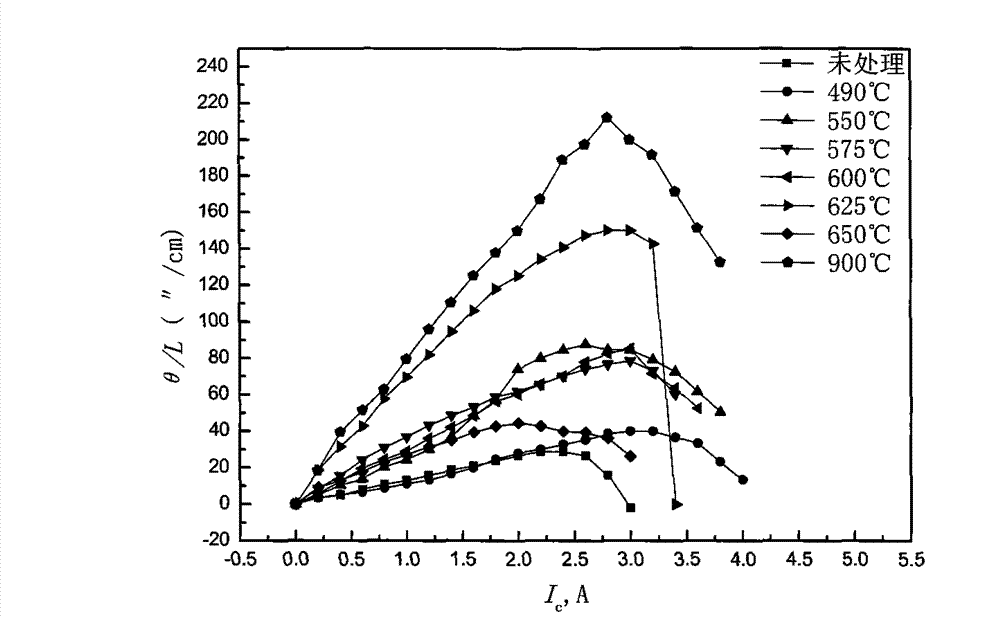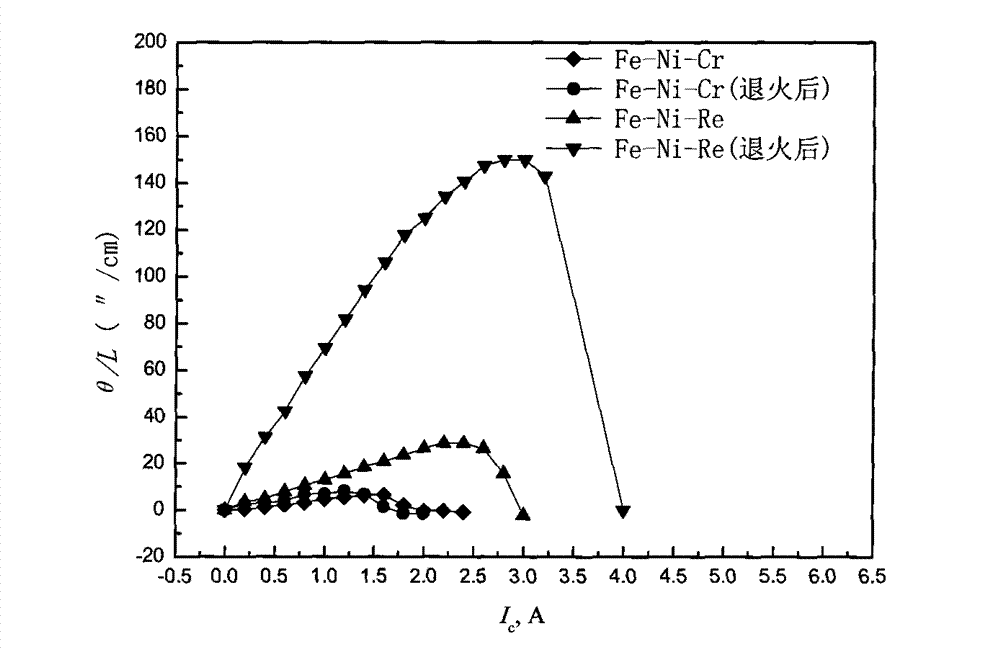Alloy wire with wiedemann effect and preparation method thereof
An alloy wire and effect technology, applied in the direction of temperature control, can solve the problems of small Wiedemann effect, weak signal, low working temperature, etc., and achieve the effect of uniform structure and performance, strong waveguide signal, and increased working temperature range.
- Summary
- Abstract
- Description
- Claims
- Application Information
AI Technical Summary
Problems solved by technology
Method used
Image
Examples
Embodiment 1
[0032] (1) Smelting alloy
[0033] Put 43.20wt% of Ni with a purity of 99.99%, 0.05wt% of Re with a purity of 99.99%, and the rest of Fe with a purity of 99.99% into a 10Kg vacuum induction furnace; the vacuum degree is 1Pa, and argon gas is introduced to start smelting the alloy , the smelting time is 1 hour; the smelting is finished and cast into an alloy rod with a diameter (Φ) of 80mm.
[0034] (2) Remove the surface layer
[0035] Some defects (mainly defects such as blisters and burrs) are prone to appear on the surface of the alloy rod after step (1), which can be turned on a lathe to make the surface smooth, and the thickness of the surface layer removed is 4mm.
[0036] The purpose of eliminating surface defects is to prevent the alloy from cracking or breaking during forging and drawing, and to ensure the uniformity of the structure of the alloy wire.
[0037] (3) Hot forging and hot rolling
[0038] The alloy rod after (2) is sent into the heating furnace and hea...
Embodiment 2
[0051] (1) Smelting alloy
[0052] The composition content of the selected alloy is: 43.18wt% Ni with a purity of 99.99%, 0.02wt% Re with a purity of 99.99%, and the remainder Fe with a purity of 99.99%. It is smelted in a vacuum induction furnace; the vacuum degree is 1Pa, and the smelting time is 1 hour; after smelting, it is poured into a Φ80mm alloy rod.
[0053] (2) Remove the surface layer
[0054] The surface layer removal thickness is 3mm.
[0055] (3) Hot forging and hot rolling
[0056] The alloy rod after (2) is sent into the heating furnace and heated to 1210°C, and then forged. After forging, it becomes a 40×40mm square billet; Carry out hot rolling, control the final rolling temperature at 970°C, and finally roll into a Φ14mm wire rod.
[0057] (4) cold drawn
[0058] The wire rod rolled in the process (3) is subjected to softening annealing at 850°C for 200 minutes; then it is pickled and washed with water; it is drawn by a drawing machine, and the total dr...
Embodiment 3
[0064] (1) Smelting alloy
[0065] The composition content of the selected alloy is: 43.22wt% Ni with a purity of 99.99%, 1.4wt% Re with a purity of 99.99%, and the remainder Fe with a purity of 99.99%. It is smelted in a vacuum induction furnace; the vacuum degree is 1Pa, and the smelting time is 1 hour; after smelting, it is poured into a Φ80mm alloy rod.
[0066] (2) Remove the surface layer
[0067] The surface layer removal thickness is 5mm.
[0068] (3) Hot forging and hot rolling
[0069] The alloy rod after (2) is sent into the heating furnace and heated to 1250°C, and then forged. After forging, it becomes a 40×40mm square billet; Carry out hot rolling, control the final rolling temperature at 1020°C, and finally roll into a Φ14mm wire rod.
[0070] (4) cold drawn
[0071] The wire rod rolled in the process (3) is softened and annealed at 930°C, and the softening and annealing time is 250min; then it is pickled and washed with water; Afterwards, intermediate ann...
PUM
| Property | Measurement | Unit |
|---|---|---|
| diameter | aaaaa | aaaaa |
| thickness | aaaaa | aaaaa |
| tensile strength | aaaaa | aaaaa |
Abstract
Description
Claims
Application Information
 Login to View More
Login to View More - R&D Engineer
- R&D Manager
- IP Professional
- Industry Leading Data Capabilities
- Powerful AI technology
- Patent DNA Extraction
Browse by: Latest US Patents, China's latest patents, Technical Efficacy Thesaurus, Application Domain, Technology Topic, Popular Technical Reports.
© 2024 PatSnap. All rights reserved.Legal|Privacy policy|Modern Slavery Act Transparency Statement|Sitemap|About US| Contact US: help@patsnap.com










